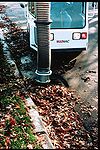
Municipal prevention practices for TSS
Municipal prevention practices for TSS.
Link to this table
Link to this table
| Practice | Method | Image |
|---|---|---|
| Temporary Construction Sediment Control | Implement and encourage practices to retain sediment within construction project area; see Temporary Construction Erosion and Sediment Control Factsheets for additional information | |
| Wind Erosion Control | Institute a local program for wetting of open construction surfaces and other sources for windblown pollutants. | |
| Streambank Stabilization | Repair erosion occurring on a streambank of lakeshore in a timely manner; inspect bank areas for ice damage in the spring. | |
| Material Storage Control 1 | Reduce or eliminate spill and leakage loss by properly inspecting, containing, and storing hazardous materials and having a cleanup plan that can be quickly and efficiently implemented. | |
| Better Turf Management 1 | Ensure that mowing, fertilization, pesticide application, and irrigation are completed in ways that will prevent or reduce grass clippings, sediment, and chemicals from entering storm sewer systems; use native vegetation where possible. | |
| Better Street and Parking Lot Cleaning 1 | Maintain streets and parking lots frequently and especially in the spring by sweeping, picking up litter, and repairing deterioration; pressure wash pavement only as needed and avoid using cleaning agents. | |
| Better Street and Parking Lot Deicing | Properly store and conservatively apply salt, sand, or other deicing substances in order to prevent excessive and/or unnecessary contamination; implement anti-icing and prewet salt techniques for increased deicing efficiency. | |
| Proper Vehicle Management 1 | Ensure that vehicles are fueled, maintained, washed and stored in a manner that prevents the release of harmful fluids, including oil, antifreeze, gasoline, battery acid, hydraulic and transmission fluids, and cleaning solutions. |
| Practice | Method | Image |
|---|---|---|
| Temporary Construction Sediment Control | Implement and encourage practices to retain sediment within construction project area; see Temporary Construction Erosion and Sediment Control Factsheets for additional information | |
| Wind Erosion Control | Institute a local program for wetting of open construction surfaces and other sources for windblown pollutants. | |
| Streambank Stabilization | Repair erosion occurring on a streambank of lakeshore in a timely manner; inspect bank areas for ice damage in the spring. | |
| Material Storage Control 1 | Reduce or eliminate spill and leakage loss by properly inspecting, containing, and storing hazardous materials and having a cleanup plan that can be quickly and efficiently implemented. | |
| Better Street and Parking Lot Cleaning 1 | Maintain streets and parking lots frequently and especially in the spring by sweeping, picking up litter, and repairing deterioration; pressure wash pavement only as needed and avoid using cleaning agents. | |
| Proper Vehicle Management 1 | Ensure that vehicles are fueled, maintained, washed and stored in a manner that prevents the release of harmful fluids, including oil, antifreeze, gasoline, battery acid, hydraulic and transmission fluids, and cleaning solutions. | |
| Storm Sewer System Maintenance | Regularly clean debris from storm sewer inlets, remove sediment from catch basin sumps, and remove any illicit connections to storm sewer systems. | |
| Better Turf Management 1 | Ensure that mowing, fertilization, pesticide application, and irrigation are completed in ways that will prevent or reduce grass clippings, sediment, and chemicals from entering storm sewer systems; use native vegetation where possible. | |
| Better Street and Parking Lot Deicing | Properly store and conservatively apply salt, sand, or other deicing substances in order to prevent excessive and/or unnecessary contamination; implement anti-icing and prewet salt techniques for increased deicing efficiency. | |
| Public Education | Label storm drains to indicate that no dumping is allowed and institute pollution prevention programs to educate and implement needed community practices. | |
| Staff, Employee, and Volunteer Education | Provide internal training for staff and provide direction to hired employees or volunteers regarding pollution prevention techniques to be used during work activites. |









